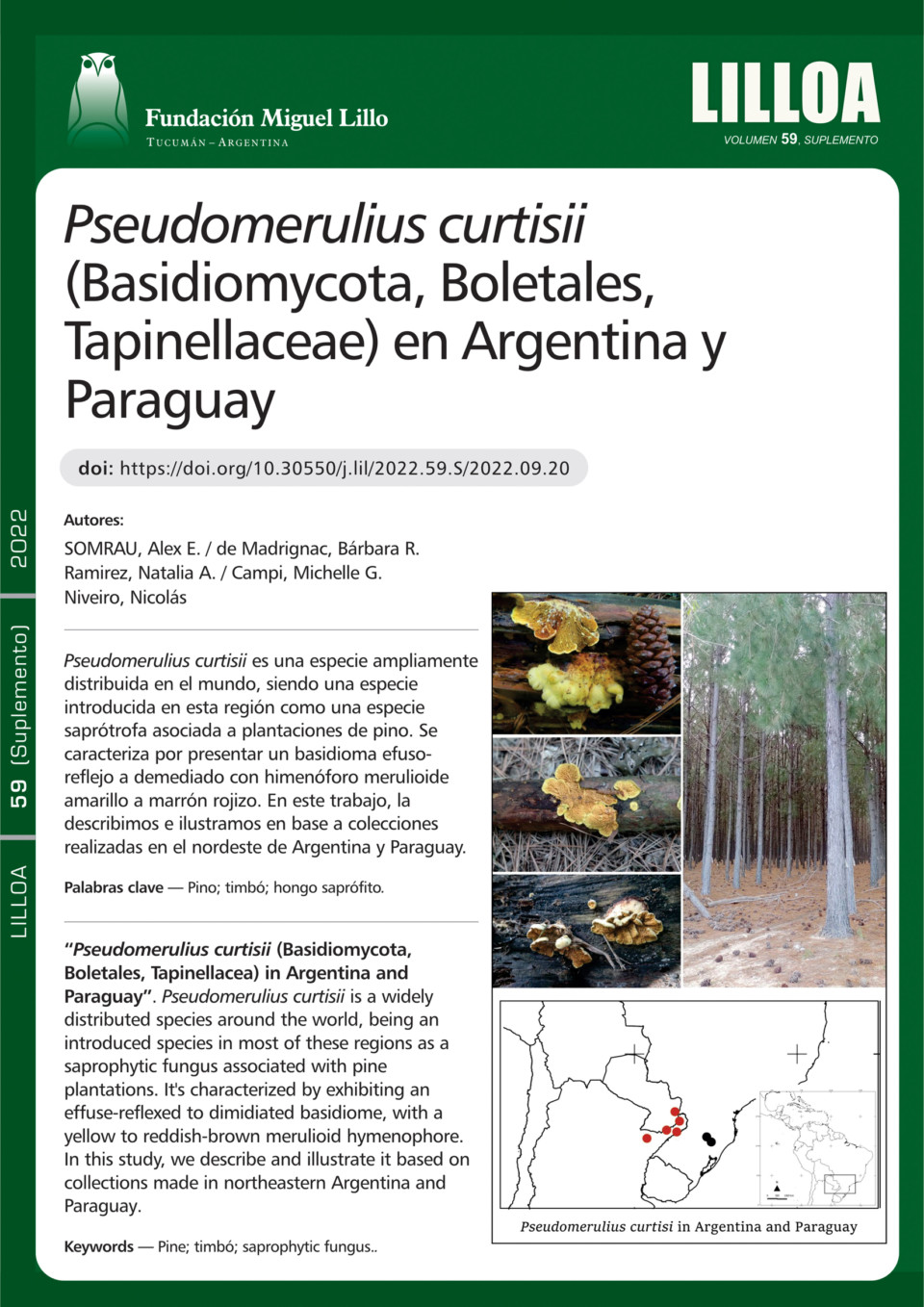Pseudomerulius curtisii (Basidiomycota, Boletales, Tapinellaceae) en Argentina y Paraguay
DOI:
Palabras clave:
Pino, timbó, hongo saprófitoResumen
Pseudomerulius curtisii es una especie ampliamente distribuida alrededor del mundo encontrándose citada para Norteamérica, Asia, Oceanía y en Sudamérica en Brasil, siendo una especie introducida en la mayoría de estas regiones al estar estrechamente asociada a plantaciones de pino como saprofita de los mismos. Se caracteriza por presentar un basidioma efuso-reflejo tendiendo a demediado cuando crece, un pileo pubecente con una coloracion amarillo grisáceo a amarillo marrón al madurar e himenóforo merulioide amarillo a marrón rojizo segun la madurez y el contenido de humedad, exhibiendo esporas amarillentas cilíndricas a elipsoidales. El sistema hifal es monomítico conformado por hifas sinuosas, ramificadas con fíbulas ampuliformes. En este trabajo, la describimos e ilustramos en base a colecciones realizadas entre 2015 y 2022 en el nordeste de Argentina y Paraguay.
Descargas
Citas
Alcántar, O. R., López, L. H., Dueñas, J. J. R., y García, D. F. (2020). Los hongos en Sierra de Quila, Jalisco, registros nuevos. e-CUCBA 13: 1-4. https://doi.org/10.32870/e-cucba.v0i13.143
Baldoni, D. B., Coelho, G., Jacques, R. J. S., Silveira, R. M. B., Grebenc, T. y Antoniolli, Z. I. (2012). Brown rotting fungus closely related to Pseudomerulius curtisii (Boletales) recorded for the first time in South America. Mycosphere 3 (5): 533-541. https://doi.org/10.5943/mycosphere/3/5/1
Berkley, M. J. y Curtis, M. A. (1853). Centuries of North American Fungi. The Annals and magazine of natural history; zoology, botany, and geology 72 (41): 423-424. https://doi.org/10.1080/03745485709495068
Binder M., Larsson K. H., Matheny P. B y Hibbett D. S. (2010). Amylocorticiales ord. nov. and Jaapiales ord. nov.: early diverging clades of agaricomycetidae dominated by corticioid forms. Mycologia 102: 865-880. https://doi.org/10.3852/09-288
Cho, D. H. y Chung, J. Y. (2013). Flora of Fugal in Mt. Umyeon Areas. Korean Journal of Nature Conservation 11 (1-2): 89-103. https://doi.org/10.30960/kjnc.2013.11.1_2.89
Díez, J. (2005). Invasion biology of Australian ectomycorrhizal fungi introduced with eucalypt plantations into the Iberian Peninsula. Biological Invasions 7 (1): 3-15.
Eriksson, J., Hjorstam, K. y Ryvarden L. (1981). The corticiaceae of North Europe. Phlebia – Sarcodontia. (5° Ed.) Fungiflora. Oslo.
Gates, G. y Ratkowsky, D. (2014). A field guide to tasmanian fungi. Tasmanian field naturalist club. Monotone Art Printers.
GBIF Secretariat. (2021). Pseudomerulius curtisii (Berk.) Redhead & Ginns. En GBIF Backbone Taxonomy. Checklist dataset. https://doi.org/10.15468/39omei. Acceso vía GBIF.org el 2022-06-27.
Ginns, J. (1998). Genera of the North American corticiaceae sensu lato. Mycologia 90: 1-35. https://doi.org/10.1080/00275514.1998.12026875
Hayward, J., Horton, T. R., Pauchard, A. y Nuñez, M. A. (2015a). A single ectomycorrhizal fungal species can enable a Pinus invasion. Ecology 96: 1438-1444. https://doi.org/10.1890/14-1100.1
Hayward, J., Horton, T. R., Nuñez, M. A. (2015b). Ectomycorrhizal fungal communities coinvading with Pinaceae host plants in Argentina: Gringos bajo el bosque. New Phytologist 208: 497-506. https://doi.org/10.1111/nph.13453
Hjortstam, K., Larsson, K. H. y Ryvarden L. (1988). The Corticiaceae of North Europe, Vol. 1, Introduction and keys. (1° Ed.) Fungiflora. Oslo.
Index Fungorum – Authors of Fungal Names (2022). http://www.indexfungorum.org/names/AuthorsOfFungalNames.asp
Jülich, W. (1979). Studies in resupinate Basidiomycetes - V. On some new taxa. Persoonia 10 (3): 325-336.
Kornerup, A. y Wanscher, J. H. (1978). Methuen handbook of colour, 3 edn. London: Eyre Methuen.
Kotiranta, H., Larsson, K. H., Saarenoksa, R. y Kulju, M. (2011). Tretomyces gen. nov., Byssocorticium caeruleum sp. nov., and new combinations in Dendrothele and Pseudomerulius (Basidiomycota). Annales Botanici Fennici 48: 37-48. https://doi.org/10.5735/085.048.0106
López Ramirez, A., García, A. J. y González, M. A. S. (2015). Meiorganum curtisii. Funga Veracruzana 145: 1-4.
Martini, E. (2016). Pseudomerulius montanus. Excerpts from crust and jells 8: 1-6.
Mora, R. N. y Garza, R. V. (1997). Los macromicetos de la Sierra de Nanchititla. Polibotánica 5: 21-36.
Nakasone, K. (2012). Type studies of corticioid Hymenomycetes (Basidiomycota) with aculei – Part II. Czech Mycology 64: 23-42.https://doi.org/10.33585/cmy.64104
Nuñez, M. A., Horton, T. R. y Simberloff, D. (2009). Lack of belowground mutualisms hinders Pinaceae invasions. Ecology 90: 2352-2359. https://doi.org/10.1890/08-2139.1
Ramírez, N., Zacarias, L. K. E., Salvador Montoya, C., Tasselli, M., Popoff, O. y Niveiro, N. (2022). Russula (Russulales, Agaricomycetes) asociated to introduced Pinus forest from northeastern Argentina. Rodriguesia 73: e02372020. https://doi.org/10.1590/2175-7860202273060
Redhead, S. A. y Ginns, J. H. (1985). A reappraisal of agaric genera associated with brown rots of woods. Transactions of the Mycological Society of Japan 26 (3): 372.
Salgado Salomón, M. E., Barroetaveña, C. y Rajchenberg, M. (2011). Do pine plantations provide mycorrhizal inocula for seedlings establishment in grasslands from Patagonia, Argentina? New Forests 41: 191-205.
Schneider, C. A.; Rasband, W. S. y Eliceiri, K. W. (2012). NIH Image to ImageJ: 25 years of image analysis. Nature Methods 9 (7): 671-675. doi: https://doi.org/10.1038/nmeth.2089
Singer, R., Garcia, J. y Gomez, L. D. (1990). The Boletineae of Mexico and Central America I & II. Beihefte zur Nova Hedwigia 98: 1-70.
Thiers, B. M. 2022 (continuamente actualizado) Index Herbariorum: a global directory of public herbaria and associated staff. New York Botanical Garden’s Virtual Herbarium. Disponible en http://sweetgum.nybg.org/ih
Urcelay, C., Robledo, G., Heredia, F., Morera, G. y Montaño, F. (2012). Hongos de la madera en el arbolado urbano de Córdoba. Córdoba: Instituto Multidisciplinario de Biología Vegetal (UNC-Conicet).
Urcelay, C., Longo, S., Geml, J., Tecco, P. A. y Nouhra, E. (2017). Co-invasive exotic pines and their ectomycorrhizal symbionts show capabilities for wide distance and altitudinal range expansión. Fungal Ecology 25: 50-58. https://doi.org/10.1016/j.funeco.2016.11.002
Wright, J. E. y Albertó, E. O. (2002). Guia de los Hongos de la región Pampeana: Hongos con Laminillas. Buenos Aires: LOLA.
Descargas
Publicado
Cómo citar
Número
Sección
Licencia
Derechos de autor 2022 Lilloa

Esta obra está bajo una licencia internacional Creative Commons Atribución-NoComercial-SinDerivadas 4.0.










